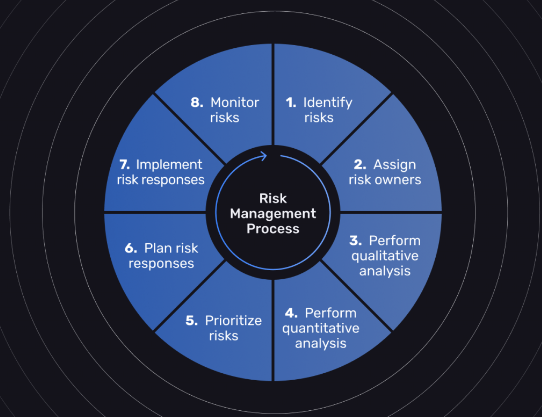
IT Project Risk Management (Image by Toolshero)

IT Project Risk Management (Image by Toolshero)
IT project risk management is about proactively identifying, analyzing, and responding to potential threats that could derail your project.
Yes, it’s all about anticipating problems and crafting solutions before they turn into costly disasters.
Neglecting risk management in IT projects is like walking a tightrope without a safety net.
The consequences can be dire: from blown budgets to missed deadlines, and in the worst-case scenario, complete project failure.
In this guide, we’ll explore IT project risk management in a way that’s straightforward and easy to grasp.
We’ll delve into how identifying, analyzing, and mitigating risks can safeguard your project’s trajectory.
Moreover, we’ll look at how risk management isn’t just a one-time task but an ongoing process that requires vigilance and adaptability.
A risk, in IT project terms, is anything unexpected that can negatively impact the project’s timeline, cost, or outcome.
Understanding risks in IT projects is like recognizing the hurdles in a relay race; they can slow you down or, worse, prevent you from reaching the finish line.
Let’s explore some common types of storm clouds. First, there are technical risks, which involve problems with the technology itself, such as software bugs, hardware failures, or compatibility issues.
Then there are operational risks, which relate to the execution of the project, such as poor communication, lack of resources, or inadequate planning.
Imagine your team running into roadblocks due to unclear instructions or lack of resources, causing delays and frustration.
Finally, external risks are factors beyond your control, such as natural disasters, economic downturns, or security breaches.
Imagine a sudden power outage causing data loss just days before launch.
Real-world examples make this clearer. Take the 2018 cyberattack on Atlanta’s city systems – a classic case of an external risk turning into a digital nightmare.
Or 2020 Boeing’s 737 MAX troubles, where faulty software and a technical risk led to tragic consequences and a damaged reputation
So, what’s the game plan? It’s about being ready for these curveballs. Think of it as keeping an eye on all corners of the field, ready to catch whatever comes your way.
That’s what IT project risk management is all about – staying one step ahead and ready for whatever challenges come up.
Now that you understand the different types of IT project risks, it’s time to arm yourself with the tools to identify and assess them effectively.
You’re constantly on the lookout for clues that could hint at potential issues. The first step is identifying risks. It’s about asking, “What could possibly go wrong?”
How exactly do you uncover these risks? Team brainstorming is your secret weapon. Gather your crew and tap into their collective experiences and insights.
Each team member can highlight potential pitfalls from their unique vantage point, shedding light on risks you might not have seen alone.
Identified those risks? Now it’s assessment time. Enter the dynamic duo of risk management tools: risk registers and risk matrices.
Picture a risk register as your personal encyclopedia of ‘what-ifs’ – a detailed catalog of every possible thing that could throw your project off track.
Meanwhile, the risk matrix is your guide to understanding just how serious each risk is. It’s like a map, plotting the likelihood of each risk against the impact it could have.
But how do you decide which risks are minor annoyances and which are project-derailers? Here’s where things get a bit more technical.
You can dive into historical data, crunch some numbers, and use expert judgment to assign hard values to each risk.
Or, if you prefer a more intuitive approach, use brainstorming sessions and expert opinions to gauge risks in a more subjective, yet insightful, way.
Remember, some risks are like little sparks that can be easily put out, while others are potential infernos. Your job is to know the difference.
Sailing the ocean is a great metaphor for navigating the risks of an IT project. The key is to have a solid IT project management plan and sample to stay on top of the unexpected.
Managing risks in IT projects involves four key phases, each crucial for ensuring a smooth journey.
Think of the Identification phase as your lookout duty. Here, you’re on high alert, scanning the project’s horizon for any potential risks. It’s like searching for icebergs in misty waters.
You’ll use brainstorming, document reviews, expert interviews, and industry insights to pinpoint technical, operational, and external risks that might steer your project off course.
After spotting these icebergs, it’s time to assess. In this phase, you’re like a navigator, determining how big and how close these icebergs are.
You’ll evaluate each risk’s impact and likelihood, much like a sailor gauging wind speeds and wave heights.
This step helps you prioritize which risks need immediate attention and which can be monitored over time.
Now, with a clear map of the risks, it’s time to respond. This is your action phase, where you decide the best course to avoid these icebergs.
You can choose to avoid them, share responsibility with others, reduce their size, or prepare to meet them head-on with a solid plan. For each identified risk, it’s a matter of choosing the right strategy.

Finally, in the Monitor and Control phase, you’re like the captain, constantly overseeing the journey. Even with a perfect plan, surprises can happen.
This phase involves keeping an eye on the effectiveness of your risk strategies, spotting new risks as they emerge, and adjusting your sails as needed.
It’s about making sure your IT project stays on track and arrives safely, no matter what.
Navigating IT project risks is like preparing for a trip in unpredictable weather-you need a solid plan to keep your project on track.
It’s vital to have strategies that act like a compass, guiding you through the challenges and preventing your project from getting lost in the storm.
In the world of IT, proactive risk management isn’t just a security measure. It’s an essential part of the journey.
Let’s dive into four key strategies that help in steering your project clear of potential hazards.
First up, risk avoidance. Picture this as choosing a calm, clear path over a stormy one. Instead of embarking on the risky venture of crafting custom software, you might opt for a pre-built solution.
Next, there’s risk transfer. Imagine passing a heavy backpack to someone better equipped to carry it.
You might hand over certain risks to an insurance company or a subcontractor, especially those rare but high-impact threats.
Then we have risk mitigation. This is about softening the potential blows.
Like applying sunscreen to protect against sunburn, you might implement thorough testing to catch software glitches early or create a backup plan for data breaches.
Finally, risk acceptance. This strategy is akin to acknowledging the possibility of light rain and deciding not to let it deter your plans.
It’s often used for minor risks where the effort of dodging them doesn’t quite add up.
Implementing those strategies is like having a map, a compass, a life jacket, and an umbrella – all essential tools for a smooth and successful IT project voyage.
They’re not just about avoiding pitfalls; they’re about ensuring your project sails smoothly towards its destination.
Imagine a gardener nurturing their garden. They don’t just plant and forget; they constantly tend to their plants.
Risk management in IT projects is similar. It involves an ongoing cycle of review and adaptation, ensuring the project’s health and growth.
Think about successful project stories. A common thread is early detection of risks and consistent monitoring.
Picture a tech firm rolling out a new software platform. Their winning strategy?
Embedding risk management right from the start. They kept a vigilant watch for potential issues, much like a captain scanning the horizon for rough seas, ready to adjust their course.
Risk management shouldn’t be a standalone activity. Instead, infuse it into every phase of your project. It’s like seasoning a dish throughout cooking, not just at the end.
Choose a leader for risk management who’s not just knowledgeable but also a strong communicator, able to navigate the complexities of the project like a seasoned pilot.
Encourage a culture where team members openly share information. It’s like a team of climbers, where each one watches out for and alerts others to potential hazards.
Leveraging risk management software is also a smart move. It’s the technological equivalent of having a high-tech dashboard, providing real-time insights and guiding decisions.
Learn from both hits and misses in projects. This practice is akin to an athlete reviewing game tapes, constantly learning and improving.
Also, align your risk management approach with industry benchmarks. It’s like comparing notes with fellow experts, ensuring your methods are top-notch.
Effective communication is crucial too. Imagine a well-coordinated team where every member knows exactly when and how to pass the baton.
Staying alert, adaptable, and communicative are the hallmarks of best practices in IT project risk management.
It’s about crafting a path that not only navigates the present but also paves the way for future successes.
The risk management framework for IT projects serves as a structured blueprint, guiding you through the complex terrain of potential project hazards.
It’s like a meticulously designed course in navigation, teaching you to chart your path through uncertain waters. The framework is composed of several key phases:
Well-known frameworks like the NIST RMF, ISO 31000, and PMI standards offer different lenses through which to view this process.
In the context of ITIL (Information Technology Infrastructure Library), risk management is akin to conducting a thorough health examination for IT services.
This concept in ITIL can be understood as a strategic and systematic approach dedicated to managing potential threats to the delivery of IT services.
ITIL’s interpretation of risk management emphasizes a detailed process that includes the identification, assessment, prioritization, and control of risks.
This approach is integral in guaranteeing the effective, efficient, and secure delivery of IT services.
This approach is essential for effective project management and risk control. The steps are:
The ICT Risk Management Framework is a strategic tool designed to assist organizations in effectively managing risks associated with information and communication technology (ICT).
The ICT Risk Management Framework is crucial for aligning ICT-related risks with the broader organizational strategy.
The ICT Risk Management Framework serves as a comprehensive guide, helping organizations not only to identify and assess potential ICT risks but also to implement suitable controls to mitigate these risks.
The IT risk assessment approach is about figuring out what could go wrong with your IT systems, data, and operations.
The IT risk assessment approach is a process where you identify, analyze, and weigh the potential threats.
This IT risk assessment approach is super helpful for organizations to get a clear picture of how serious these threats are and how likely they are to happen.
Based on this assessment approach, you can decide which risks need immediate attention.